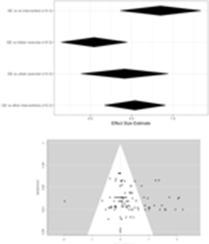一项系统回顾和荟萃分析表明绿色运动干预对心理健康的积极影响
IF 2.2
Current research in ecological and social psychology
Pub Date : 2025-01-01
DOI:10.1016/j.cresp.2025.100244
引用次数: 0
摘要
接触大自然和体育锻炼都被证明对心理健康有积极影响。我们回顾了大自然中体育锻炼(即“绿色运动”)对心理健康的综合影响。通过对Ovid Medline、PubMed和PsycINFO数据库的系统回顾,共纳入了57项研究(其中25项是荟萃分析)。所有符合条件的研究都将绿色运动干预与:(1)无干预对照组,(2)室内运动,(3)城市运动或(4)其他改善心理健康的干预进行了比较。没有对照组的研究被排除。我们的研究结果显示,绿色运动干预对心理健康有积极影响(0.478;p = 0.001; 95% CI =[0.191, 0.766])。亚组分析显示,与无干预对照组(5项研究;0.851,se = 0.248, p < 0.001)和其他心理健康干预组(8项研究;0.540,se = 0.188, p = 0.05)相比,绿色运动干预对心理健康有更积极的影响,但与室内(5项研究;0.04,se = 0.203, p = 0.819)或城市运动(10项研究;0.415,se = 0.268, p = 0.124)相比,绿色运动干预对心理健康没有更积极的影响。虽然绿色运动在增强心理健康方面明显优于不运动和非身体干预,但它对其他形式的身体活动的好处可能更加微妙,可能受到持续时间、环境质量和测量灵敏度等因素的影响。未来的干预措施应该探索哪些类型的绿色运动是最有益的,哪些人群可能从参与绿色运动中获益最多(例如,临床、青年、移民社区)。本文章由计算机程序翻译,如有差异,请以英文原文为准。

A systematic review and meta-analysis demonstrating a positive effect of green exercise interventions on mental well-being
Both exposure to nature and physical exercise have been shown to have positive effects on mental well-being. We reviewed the combined effects of physical exercise in nature (i.e., ‘green exercise’) on mental well-being. A systematic review of the databases Ovid Medline, PubMed and PsycINFO resulted in a total of 57 included studies (of which 25were meta-analysed). All eligible studies compared a green exercise intervention with: (1) a no intervention control group, (2) indoor exercise, (3) urban exercise, or (4) other interventions to improve mental well-being. Studies without a comparison group were excluded. Our results show that green exercise interventions have a positive effects on mental well-being (0.478; p = 0.001; 95% CI = [0.191, 0.766]). Subgroup analyses revealed that green exercise interventions had more positive effects on mental well-being compared to no-intervention control groups (5 studies; 0.851, se = 0.248, p < 0.001) and other mental well-being interventions (8 studies; 0.540, se = 0.188, p = 0.05), but not compared to indoor (5 studies; 0.04, se = 0.203, p = 0.819), or urban exercises (10 studies; 0.415, se = 0.268, p = 0.124). While green exercise clearly outperforms no activity and non-physical interventions in enhancing mental well-being, its benefits over other forms of physical activity may be more nuanced, potentially moderated by factors such as duration, environmental quality, and measurement sensitivity. Future interventions should explore what types of green exercise are the most beneficial, and which populations may benefit the most from participation in green exercise (e.g., clinical, youth, migrant communities).
求助全文
通过发布文献求助,成功后即可免费获取论文全文。
去求助
来源期刊

Current research in ecological and social psychology
Social Psychology
CiteScore
1.70
自引率
0.00%
发文量
0
审稿时长
140 days
 求助内容:
求助内容: 应助结果提醒方式:
应助结果提醒方式:


